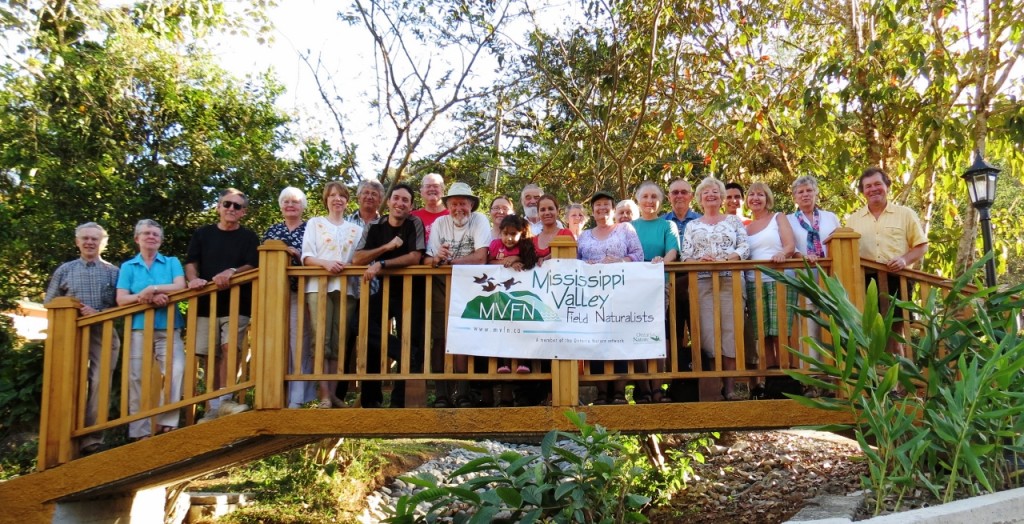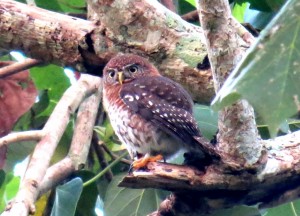MVFN press story by Mary and Howard Robinson
Seventeen members of the Mississippi Valley Field Naturalists recently returned from the group’s fourth international field trip, which was to observe the wonders of the natural world including some Canadian-born birds overwintering in a warmer climate in Cuba.
Photo of MVFN group in Cuba (click on photo to enlarge or see link to labelled MVFN Cuba 2013 group photo), taken with a timer by Howard Robinson. l-r: Murray and Karen Hunt, Perth area; Dave Milsom, Canadian leader, Peterborough; Mary Vandenhoff, McDonalds Corners; Mary Robinson, Clayton; Rolando, Cuban bus driver; Yuri Napoles Padron, Cuban leader; Joel Byrne, Pakenham; Cliff Bennett, Group organizer; Donna Lee Pullen, Ramsay; Mirtha Marie, Cuban guest; Howard Clifford, Blueberry Mountain; Dr. Yenalis Portales, Cuban guest; Terry McIver, Arnprior; Anne Mason, Almonte; Tim Pullen, Ramsay; Jean Clifford, Blueberry Mountain; Al Potvin, Almonte; Brenda Boyd, Almonte; Dr. Alain Porteles Cruz, Cuban guest; Aileen Young, Ottawa; Pip Winters, Almonte; and Howard Robinson, Clayton.
Travelling during the first two weeks of February 2013, the group visited the eastern provinces of Cuba, complementing the 2010 trip to the western provinces. Arriving in the city of Holguin, we met our Cuban tour guide and bus driver. We knew we were off to a good start as our guide was well known to some of us from our previous trip and the driver turned out to be a keen birder.
Barely away from the airport, soaring turkey vultures and white cattle egrets were the first birds we spotted. These common birds were seen many times, but thanks to continuous observation and the early morning bird walks led by our Canadian leader David Milsom, many more interesting and beautiful birds were observed throughout the trip – about 116 different species in total. Highlights included endemic birds such as the Cuban Trogon, the Cuban Tody, the Cuban Pygmy Owl and the Cuban Emerald hummingbird; spectacular birds such as the Great Lizard Cuckoo, the Magnificent Frigatebird and a barn owl feeding its chicks; and many birds that will head north soon such as the herons, warblers and kingfishers. In addition to birds, we saw lizards, beautiful butterflies, lovely orchids and other flowers, numerous palm trees and other semi-tropical vegetation.
Cuban Pygmy Owl, spotted by MVFN members; 18 cm, which is smaller than our saw-whet owl. Click on photo to enlarge Photo by Howard Robinson
Our first destination was La Mensura National Park in the high plateau of Nipe where we noticed the changing vegetation as we travelled ever higher through the mountainous rain forest area. Our first nature-walk included sightings of many local birds and views of the spectacular Guayabo Waterfall, one of the highest in Cuba. Our next destination was Baracoa on the Eastern Cuban Atlantic Coast, one of the oldest colonial towns in Cuba. The road leading to Baracoa was challenging, to say the least, due to huge potholes, wash-outs and rocks from previous rainy seasons. Baracoa was the landing point of Christopher Columbus and the first settlement of the Spanish Conquistadores in Cuba.
Our hotel in Baracoa was situated high on a hill overlooking the harbour and ocean with a terrific view of the flat topped mountain of El Yunque. From this base, we visited Humboldt National Park, a UNESCO World Heritage site and home to 30 percent of Cuba’s endemic plants. Here we had an adventurous nature walk, climbing up and down hills, some slippery with red mud, and crossing a rapidly moving river four times. Helping each other on the crossings, we survived with only one dunking. Our efforts were rewarded when our local Cuban guide found the elusive ‘world’s smallest frog’ – so small it sits on an adult’s pinky finger nail. Some other activities in the Baracoa area included a nature walk to explain the chocolate making process; a row-boat ride to a local farm where we ate fresh fruit from the trees and were shown how to climb palm trees; and a tour of the natural history museum.
From Baracoa we took a spectacular drive over the mountains and down to the Caribbean ocean and surrounding countryside. In the rain shadow of the Sierra Maestra Mountains, we visited the nearby Bacanao National Park – a parched strip of land declared a biosphere reserve by UNESCO. On the way to Santiago we visited a cactus garden and in this lovely city we learned more about the history of Cuba and toured the fort of El Morro initially built in the 1600s to guard the entrance to Santiago Harbour from pirates.
While driving throughout the ever-changing countryside from Santiago to Chivirico, we noted with despair the remaining damage from Hurricane Sandy which had devastated that area in the fall of 2012. At our resort on the Caribbean coast we had two glorious days to relax, and swim or snorkel in the ocean at a nearby coral reef.
Another drive to the mountains led us to the famous El Cobre Shrine dedicated to the Virgin of Charity. Our stay at the El Salton Lodge was exceptional. Here we had excellent views of a Cuban Pygmy Owl, a Louisiana waterthrush, Cuban Grassquits, red-legged honey creepers, and more. Other activities were walking in the mountainous terrain, spontaneously singing “the hills are alive with the sound of music”, and being introduced to local villagers living in the mountains.
Our next destination was the city of Bayamo, founded in the early 1500s. It was here that the national anthem of Cuba was first sung at the church near the main square. And it was here that our Cuban guide and bus driver sang their national anthem for us and we in turn stood in the bus and sang “Oh Canada” for them – another special memory.
Following a tour of the city of Bayamo, we headed to the Sierra Maestra mountain range where Fidel Castro’s 1950s revolutionary army built its headquarters high in the mountains and deep in the forest. We had an exciting hair-pin-turn car ride up the mountain and then hiked another few kilometres over rough terrain to Fidel’s rustic camp buildings – now a museum for the Cuban people and only to be treated with great respect.
After two wondrous days in the Sierra Maestra mountains we returned to Holguin in preparation for our trip to Toronto the next day. Of course we had a party on our last night to thank our Cuban friends and to celebrate our many experiences and new or renewed friendships. There are indeed many more memories: street scenes in the villages and towns; old cars and other interesting vehicles; rural houses with goats, pigs and chickens nearby; Cuban art, music and food; children in school uniforms; the Spanish language; and, of course, the overall resourcefulness of the Cuban people. We have only touched on a few memories and each of us has our own experiences to ponder. We all owe our thanks to MVFN’s Cliff Bennett for organizing the trip through Worldwide Quest tours, and to Quest leader, Dave Milsom an excellent birder and naturalist, who both made our trip to Cuba a truly wondrous experience.









